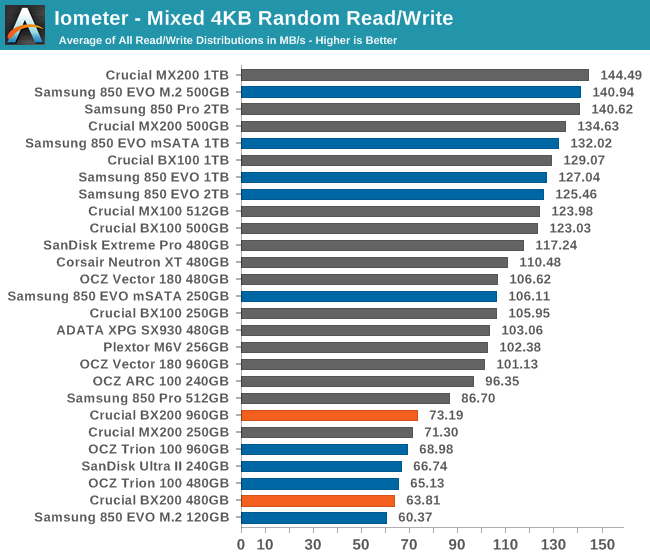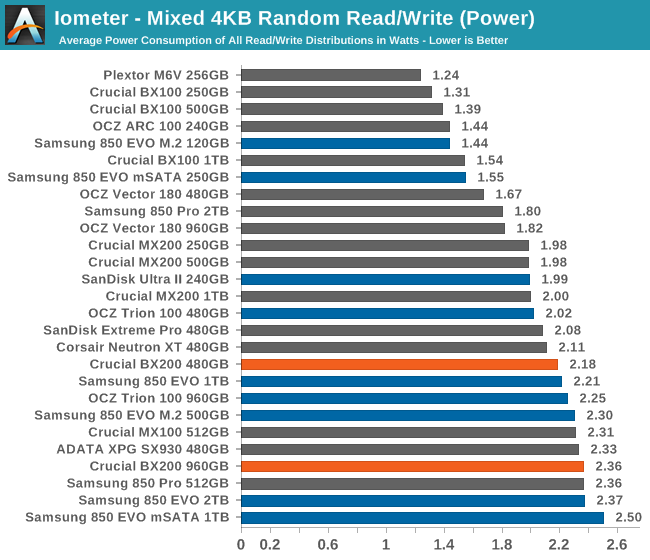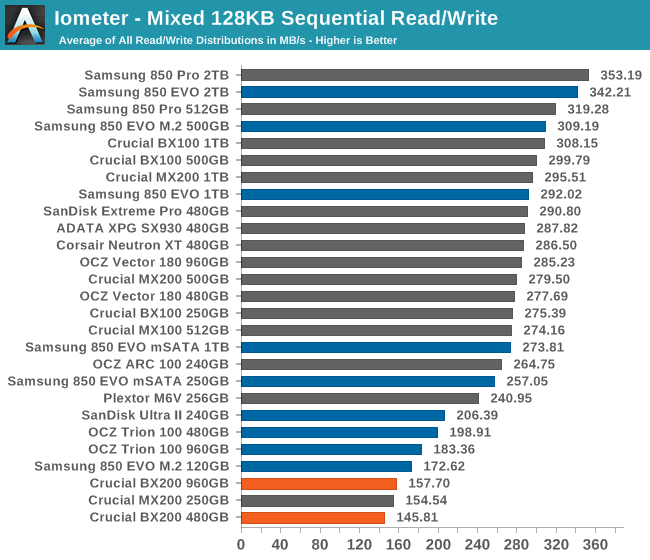The Crucial BX200 (480GB & 960GB) SSD Review: Crucial's First TLC NAND SSD
by Billy Tallis on November 3, 2015 9:00 AM ESTMixed Random Read/Write Performance
Most real-world use consists of a mix of reads and writes, and interleaving the two often poses a particular challenge to drive controllers. This mixed random access test is conducted across a 16GB span of the drive, with a queue depth of 3.

The BX200's reasonable read speeds are apparently able to compensate for the write performance enough to keep at least the 960GB BX200 out of last place for the mixed random test, but the 480GB only manages to surpass a 120GB drive.

The power draw is even more mainstream than the performance, because despite being inefficient the BX200 isn't unreasonably power hungry in an absolute sense.
 |
|||||||||
| Default | |||||||||
Slow and steady doesn't win the race here. Most drives gain speed near the end of the test for the write-heavy portions, but the BX200 gains no performance as the power consumption climbs. It doesn't have the slight bathtub curve shape in the middle the way the Trion 100 does, which is how it keeps pace even without the boost at the end.
Mixed Sequential Read/Write Performance
At either end of this test, when the workload is heavily skewed toward either reads or writes, most drives perform well. In between, performance typically suffers greatly, and that's where the winners and losers of this test are usually determined. Anything that's duplicating or transforming a large amount of data on the drive will produce I/O patterns similar to this test. Creating a System Restore snapshot, backing up files to a different location on the same drive, and file compression can all produce interleaved reads and writes of large blocks of data, though not necessarily fast enough to be limited by the drive's performance. Heavy multitasking can add up to a mixed workload.

With average read speeds and poor write speeds, the BX200 is in last place for the overall average, since the competition didn't have any acute weaknesses.

Average power consumption is once again high, and the 960GB is a particular outlier.
 |
|||||||||
| Default | |||||||||
The graph of performance as more writes come into the mix shows just how quickly things get bad. There's a big jump in power consumption once writes are more common than reads, and the drive is almost as overwhelmed at 40/60 as it is for the pure writes.










85 Comments
View All Comments
zeeBomb - Sunday, November 8, 2015 - link
Less bits the better?Dahak - Tuesday, November 3, 2015 - link
So I had primarily just skimmed the article, but for a successor to the BX100 its not.I wonder if there is some firmware bug that might be causing an issue.
I have used the BX100s fine in general office settings, but i many need to pass on these and start to look for an alternative
mczak - Tuesday, November 3, 2015 - link
Honestly I think the BX200 as a cheap SSD makes sense. The problem with the BX100 was that it was "too good". There was just about no difference in performance to the MX200 (faster in some benchmarks even), there was some feature differences (for instance no AES encryption, albeit this seems to have been an artificial firmware limitation as the controller supports it) but who cares about that in client ssds. But on the downside, there was just about no price difference to the MX200 neither, some shops selling some capacities of the BX100 actually for more than the same capacities for the MX200 sometimes. So the Crucial BX100 and MX200 were really pretty much the same in nearly all aspects.But with BX200 this changes - the MX200 now clearly is the better product, but the BX200 definitely is cheaper (or at least retail prices really need to be cheaper). Albeit the benchmarks are definitely concerning - even with tlc nand it shouldn't be THAT bad, maybe indeed the firmware is to blame.
hojnikb - Tuesday, November 3, 2015 - link
Actually, TLC is pretty bad and is mostly the sole reason why this drive performs so badly. Remove the SLC cache and it would be much worse (especially on paper).mczak - Tuesday, November 3, 2015 - link
I don't quite agree. There's other tlc nand ssds in the benchmarks. Even if you exclude the 850 Evo (with its 3d nand) there's still the (toshiba tlc nand based) ocz trion 100. And this performs quite ok - sure it's not exactly leading but it doesn't trail by huge amounts in some benchmarks like the bx200 does. I'd have expected the bx200 to perform close to that rather than a league of its own as far as slow ssds go... I don't know though if that's due to differences between toshiba tlc and micron tlc or if that's due to controllers.Drumsticks - Tuesday, November 3, 2015 - link
It can't be *just* the NAND. The other TLC based drives in the charts perform much closer to "mainstream" than "absolutely terrible at everything"hojnikb - Tuesday, November 3, 2015 - link
its pretty hard to make good tlc. so yeah, tlc from micron simply sux. no other way around it.its no controllers fault, as it should perform just fine on its own, since its based off *46
DanNeely - Tuesday, November 3, 2015 - link
Assuming the street price does settle in at a reasonable discount to MSRP (and thus is cheaper than most other budget drives), these look like a reasonable option for office work. It look ~4 minutes of sustained full writes for the 480GB model to choke. Outside of photo/video editing the only time a normal user is going to hit that long of a sustained write is for OS or very large software installs. The rest of the time, most writes will be a few seconds at most before an idle period gives the drive time to catch up and flush the ram/SLC caches; meaning they should mostly sit in the (short) burst where the drives IO is similar to what much higher end drives achieve; and most longer operations will still fit in the middle plateau which is similar in performance to most budget drives on the market.beginner99 - Tuesday, November 3, 2015 - link
Too expensive or too low performance. I think everyone can afford that $20 to step up to a MX200 or similar. And this $20 is more than worth it given the extra performance. Off topic but I would also like how older SSDs fare in these benches just as a comparison. Say I have an intel G2, will I actually gain anything noticeable from moving to a new SSD?Mangosteen - Thursday, November 5, 2015 - link
Yup! You can go to anandtechs excellent bench:http://anandtech.com/bench/SSD/65
The 2013 benchmarks include a "Intel X25-M G2 160GB" (or the 80GB) which is what I'm going to assume is an Intel G2.
You can compare 1 to 1 with any SSD for example with a 250GB 850 Evo you see big gains just about everywhere, so you will definitely gain performance but will that actually be noticeable to you i have no idea because it depends on what you will use it for. For sure it won't be AS big a gap as going from a HDD to an SSD was but you may notice some small gains. It's hilarious because in the overall listing of all the ssd's there is a "Velociraptor 10,000 rpm" HDD to compare to the SSD's which is awesome. Keep in mind also that you get a new (probably better) warranty and a larger guaranteed durability.